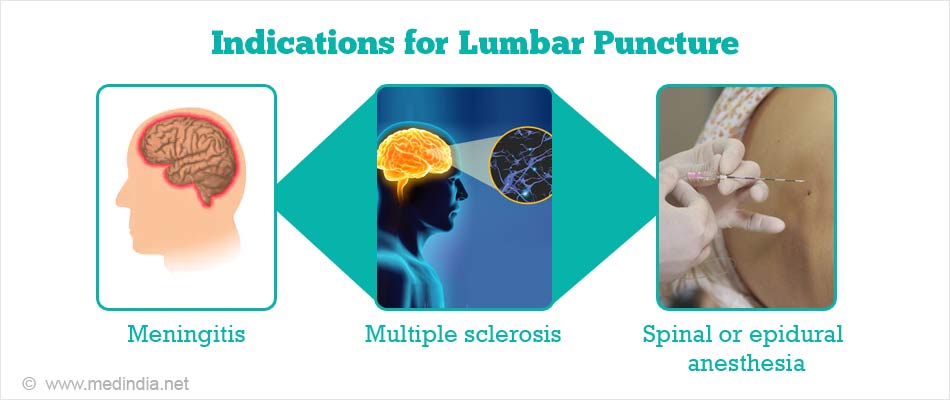What is Lumbar Puncture?
Lumbar puncture or spinal tap is a minor diagnostic surgical procedure performed, usually to obtain a sample of cerebrospinal fluid (CSF), for various indications. The CSF bathes and cushions the brain and spinal cord and can provide a lot of information about what is happening within the nervous system.
What is Cerebrospinal Fluid?
- Cerebrospinal fluid or CSF is the clear liquid around the brain and spinal cord. It is produced by a group of cells, called the choroid plexus, deep inside the brain. Normally, the body has about 150 ml of fluid - roughly two-thirds of a cup.
- As the colorless fluid flows around the brain and spinal cord, it protects those organs, picks up essential supplies from your blood, and eliminates waste products from brain cells.
- Since the CSF is in close proximity to the brain and spinal cord, conditions affecting the brain and spinal cord will be reflected by changes in CSF composition and appearance
- If a doctor suspects an illness involving the nervous system, he might take a CSF sample for testing
The indications for a lumbar puncture include the following
- Obtaining a CSF sample to diagnose certain infections (meningitis) – (as emergency procedure)
- Diagnosis of certain conditions – multiple sclerosis, cancer of brain and spinal cord, brain hemorrhage, transverse myelitis
- To measure CSF pressure (increased CSF pressure can be dangerous)
- To estimate levels of certain chemicals for diagnosing certain conditions
- For treatment purposes – to inject drugs, chemotherapy, painkillers or antibiotics
- For spinal or epidural anesthesia – to numb the lower half of the body before certain surgical procedures
What happens Before, During and After Lumbar Puncture?
Before Lumbar Puncture
- A few days before a lumbar puncture a CT or MRI scan of brain is done to ensure it is safe to proceed and there are no contraindications
- You should inform your doctor about any blood thinning medications you may be regularly taking such as warfarin which you may be advised to omit for a few days prior to the procedure
- On the day of the procedure you should not take food or milk orally for at least six hours before the procedure. Clear fluids may be taken for up to two hours before.
- The procedure will be explained to you and you will be asked to sign a consent form
- Before the procedure you will have to change into a hospital gown and will then be wheeled into the operation room
During the Procedure – Inside the Operating Room
- You will be asked to lie on your side with the legs folded close to the body to enable the bones of the spine to be easily visible
- The skin of the back will be cleaned with sterile antiseptic and draped with a sterile towel leaving only the surgical site visible
- The procedure can be done by injecting local anesthetic into the skin of the back so that there is no pain but in very young children or highly anxious patients, general anesthesia may become necessary
- The site of lumbar puncture is the space between two adjacent bones (so that the needle can go through) in the lower back. As the needle is being inserted, there may be a sharp pain in the back or leg
- Once the needle is in place, CSF will slowly flow out and is collected in a sterile container and sent to the laboratory for investigations. Usually the needle remains in for about one to two minutes
- Occasionally the doctor will want to check the pressure of the CSF coming out and this is done by attaching a special tube to the needle
- After the required amount of CSF has been obtained and CSF pressure measured, the needle is gently removed and a sterile plaster is applied over the injection site
Immediately After the Lumbar Puncture – In the Recovery Room
- The procedure usually lasts about 45 minutes. After the procedure you will be shifted to the recovery room and vital signs monitored for around an hour
- You can usually go home the same day but may need someone to drive you home
Recovery at Home Following Discharge
- If you have headaches or pain at the site paracetamol may help. Usually the pain settles within a day or two
- Drink plenty of fluids and stay well hydrated
- Avoid sitting upright; lie down. This will reduce CSF leak
- The plaster can be removed in 24 hours
- Do not drive or operate heavy machinery for a minimum of 24 hours
- Avoid strenuous activities, lifting weights or playing contact sports for at least a week
Lumbar puncture is a safe procedure but may be associated with complications occasionally such as
- Bleeding at site
- Local infection at the site
- Headaches which may last up to a week
- Local pain and swelling due to CSF leak. Will usually resolve spontaneously
- Nerve damage – extremely rare










